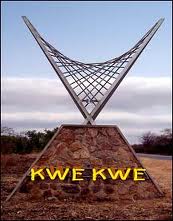Kwekwe
| Kwekwe | ||
|---|---|---|
| City | ||

Main Street.
|
||
|
||
| Nickname(s): kwelakwela | ||
| Coordinates: 18°55′S 29°49′E / 18.917°S 29.817°ECoordinates: 18°55′S 29°49′E / 18.917°S 29.817°E | ||
| Country | Zimbabwe | |
| Province | Midlands | |
| District | Kwekwe | |
| Established | 1898 | |
| Government | ||
| • Type | city Council | |
| • Mayor | Stefan Bonyongwa | |
| • Member of Parliament, MP | Masango Matambanadzo (Blackman) | |
| Elevation | 1,220 m (4,000 ft) | |
| Population | ||
| • Total | 100,900 | |
| 2012 census | ||
| Time zone | SAST (UTC+1) | |
| • Summer (DST) | gmt+2 (UTC) | |
| Area code(s) | 055 | |
| Climate | BSh | |
| Website | www |
|
Kwekwe (/ˈkweɪkweɪ/ KWAY-kway) (known until 1983 as Que Que), is a city in central Zimbabwe.
It is located in Kwekwe District, in Midlands Province, in the center of the country, roughly equidistant from Harare to the northeast and Bulawayo to the southwest. Its population stood at 47,607 in 1982, 75,425 in 1992 and the preliminary result of the 2002 census suggests a population of 88,000. In 2012, the city's population was estimated at 100,900 people. It is a centre for steel and fertiliser production in the country.
Kwekwe and neighbouring Redcliff are the headquarters of Zimbabwe Iron and Steel Company (ZISCO), the country's largest steelworks. It also hosts the Zimbabwe Iron and Smelting Company (ZIMASCO), the largest ferrochrome producer, and one of the biggest power generating plants, ZESA-Munyati, in Munyati, a suburb of Kwekwe. Kwekwe is Zimbabwe's richest city in terms of minerals.
Kwekwe town was founded in 1898 as a gold mining town, and hosts Zimbabwe's National Mining Museum. The town remains an industrial centre of the country. The name stems from the Zulu word "isikwekwe", which means "scurvy", "mange" or "scab". Popular belief states that Kwekwe is named after the croaking noise made by the nearby river's frogs.
...
Wikipedia


